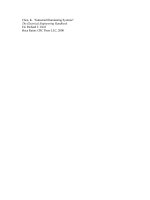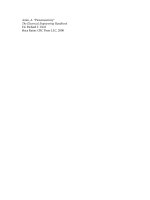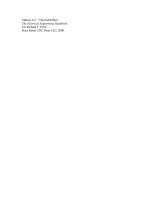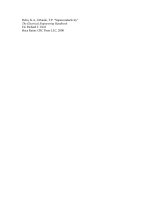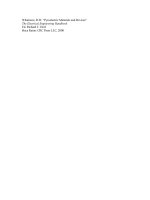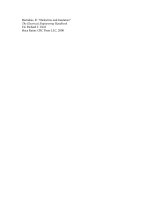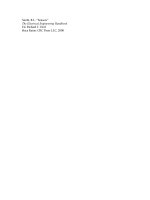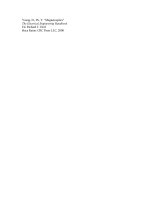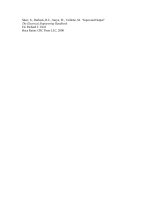The vibration analysis handbook (malestrom)
Bạn đang xem bản rút gọn của tài liệu. Xem và tải ngay bản đầy đủ của tài liệu tại đây (13.2 MB, 345 trang )
THE
VIBRATION
ANALYSIS
HANDBOOK
First Edition
Second Printing
TABLE
OF
CONTENTS
CHAPTER ONE:
INTRODUCTION TO MACHINERY VIBRATION
TheoryofVibration
1
HarmonicMotion
1
Periodic Motion
1
RandomMotion
3
The Relationship between Time and Frequency
3
Time
3
Frequency
4
Amplitude Measurement
6
Sources of Frequencies
8
Generated Frequencies
8
Excited Frequencies
9
Frequencies Caused by Electronic Phenomena
17
ForcingFunction
20
Combinations of Machine Problems
21
Mixing Frequencies
22
Electrical and Mechanical Relationship
23
Time and Frequency Domain
24
Relationship between Velocity. Displacement. and Acceleration
25
Units of Measurement
27
Relationships
27
Ways of Measuring Vibration
32
Relation between Diameter. Speed. and RPM
32
How To Determine Machine Speed in FPM from the Vibration Data
33
Conclusion and Efficiencies
34
CHAPTER
TWO:
TIME AND FREQUENCY ANALYSIS TECHNIQUES
Introduction
35
Basicphysics
35
Single Frequency
36
Single Frequency with Harmonics
41
Clipping
52
SquareWave
52
Natural Frequencies
55
Multiple Frequencies
.
Linear Systems
55
High Frequency Riding a Low Frequency
55
Multiple Frequencies
.
Nonlinear Systems
56
AmplitudeModulation
57
Sum and Difference Frequencies
61
Pulses
65
FrequencyModulation
67
Conclusion
68
CHAPTER THREE: HARDWARE AND SOFTWARE REQUIRED FOR ACCURATE
DIAGNOSTICS
Hardware
71
Introduction
71
Personal Computer 72
Real-time Analyzer
73
Datacollection
76
Printers
78
Transducers
78
Displacement Transducers
79
Velocity Transducers 81
Accelerometers 82
Pressure Transducers
83
Microphones
83
Once-Per-Revolution Markers
84
Multiplexer
85
Gauss Meter 87
Software 87
Introduction
87
Group
1.
Toolbox Software 90
Signal Analysis Program 90
Vibration Calculation Program
90
Resonance and Deflection Calculator
(RADC)
92
Bearing Calculation Program
92
Gears Program
95
Roll Ratio Program and Rusch Chart
97
Group 2. Machine Doctor (MACHDOC)
98
MACHDOC
98
Polar Plot 100
Time Plot 102
Balancing 102
Diagnostic Database 103
Diagnostic Modules 108
Roll Quality Assurance Program 109
Group3 110
Group4
110
CHAPTER FOUR: ACCURATE EVALUATION OF MACHINERY CONDITION
Introduction
111
Theory
111
Calibration 115
Frequencies Generated 116
Datacollection
117
Transducer Selection 118
Continuous Monitoring 118
CommonProblems 119
Imbalance
119
Bentshaft
119
SoftFoot
122
Misalignment
122
Looseness
125
Bearings Loose on the Shaft
125
Bearings Loose in the Housing
126
Common Forms of Looseness
128
Noise
128
Diagnosis of Looseness
129
Resonance
129
Rubs
130
Problems That Cause Pulses
130
OilWhirl
134
Analysis of Electric Motors
135
Motors Out-of-Magnetic Center
136
Broken Rotor Bars
139
Turn-To-Turn Shorts in Windings
143
Vibration Problems in Synchronous Motors
144
SirenEffect
146
Solo Data on Motors
146
Steam Turbines
148
Pumps
150
Impeller Contact
150
Starvation
151
Cavitation
152
Compressors
152
Fans
154
Special Tests
155
Startup/Coast Down Data
155
Bump Tests
158
Noise Recording
160
Synchronous Time Averaging (STA)
161
Relative Motion Measurements (RMM)
164
CHAPTER FIVE: ACCURATE DIAGNOSIS OF ANTIFRICTION BEARINGS
Introduction
167
Datacollection
167
Transducer Selection
167
Generated Frequencies
167
Fundamental Train Frequency
168
Ball Pass Frequency of Outer Race
169
Ball Pass Frequency of Inner Race
170
Ball Spin Frequency
170
Application of the Bearing Formulas
172
Outer Race Analysis
175
Inner Race Analysis
176
Ball Spin Frequency Analysis
176
Fundamental Train Frequency Analysis
177
VCI Bearing Calculation Program
177
Bearing Defects
178
Raceways
178
Outer Race
178
InnerRace
181
Outer and Inner Race Amplitude
185
Modulation of Ball Pass Frequency
185
Rolling Elements. Balls. and Rollers
186
Cage
189
Multiple Defects
189
Progressive Bearing Failure
193
Defectseverity 196
Bearing Behavior
196
Inner Race Defect Length
197
Defect Length Calculation
201
.
Deep Fatigue Spalls vs Shallow Flaking
203
Problem Sources
208
Acid Etching
208
Fluting
210
Inadequate Lubrication
214
Looseness
216
Bearings That Have Excessive Internal Clearance
216
Bearings That are Turning on the Shaft
219
Bearings Loose in the Housing
220
Testing for Bearing Frequencies
220
Conclusion 222
CHAPTER SIX: ACCURATE EVALUATION
OF
GEARS
Introduction
225
Data Acquisition
225
How To Take Data
225
Transducer Selection
226
Gear Vibration Theory
227
Evaluation of Gear Ratios
227
Factoring
227
Gearmesh Frequency
228
Fractional
Gearmesh Frequency
229
Hunting Tooth Frequency
230
Planetary Gears
231
Digression
233
End Digression
236
Gear Life Expectancy
242
Amplitude Modulation
243
The Gears Program
244
The AGMA Quality Number System
245
Gear Problems and Causes 246
Eccentric Gears 246
Meshing Gears That Have a Common Factor and One
Gear Is Eccentric 246
Gears That Do Not Have a Common Factor and One
or Both Gears Are Eccentric
257
Gears That Are Out-of-Round or Have Several High Places 262
Gears Installed on a Bent Shaft
265
Loose and Worn Gears
268
Misaligned Gears
269
Backlash Problems or Oscillating Gears
270
Broken. Cracked. or Chipped Teeth
274
Conclusion
285
CHAPTER SEVEN: ANALYZING AND SOLVING PRESS ROLL AND NIP PROBLEMS
Introduction
287
Vibration Theory of Rolls In
Nip
288
Hardware
288
Software
289
Synchronous Time Averaging
289
Hardware Setup
292
Dynamic Measurement of Rolls
294
Problems Associated with Rolls In Nip
297
Eccentric Rolls
297
Improper Ratios of Roll Sizes
297
Resonant Frequencies
299
Installation of Improperly Ground Rolls
301
Diagnosing Problems
302
Data Collection and Analysis of Overall Vibration Data
302
Relative Motion between Rolls
306
Conclusions and Recommendations
328
References
329
AppendixA 331
AppendixB 341
Glossary
343
Index 355
CHAPTER
ONE:
THEORY OF VIBRATION
The physical movement or motion of a rotating machine is normally referred to as
vibration. Since the vibration frequency and amplitude cannot be measured by sight or
touch, a means must be employed to convert the vibration into a usable product that can
be measured and analyzed. Electronics, mechanics, and chemical physics are closely
related. Therefore, it would logically follow that the conversion of the mechanical
vibration into an electronic signal is the best solution. The means of converting the
mechanical vibration into an electronic signal is called a transducer. The transducer
output is proportionate to how fast the machine is moving (frequency) and how much the
machine is moving (amplitude). The frequency describes what is wrong with the machine
and the amplitude describes relative severity of the problem. The motion can be
harmonic, periodic, and/or random.
All harmonic motion is periodic. However, all
periodic motion is not harmonic. Random motion means the machine is moving in an
unpredictable manner.
Harmonic Motion
Harmonic motion is characteristically a sinusoid or some distorted version, depending
upon the harmonic content, as in Fig.
1-1.
All harmonic motion is periodic, meaning it
repeats at some point in time. In a linear system, imbalance in rotating equipment could
generate harmonic motion. However, with many variables such as gear problems,
looseness, bearing defects, misalignment, etc., such sinusoids are not often found. It is
important to understand that a sine wave is simply a plot of a circle against time. Notice
how the circle in Fig.
1-1
can be plotted as a sine wave, proving that linear motion is
harmonic. All harmonic motion is repeatable and is just one form of periodic motion.
L
one
cycle
2
I
I
Periodic Motion
Periodic motion is all motion that repeats periodically. This includes harmonic motion,
pulses, etc. Periodic motion is any motion that repeats itself in equal time periods. For
example, a misaligned motor coupling that is loose could have a bump once per
revolution of the shaft. Although this motion is not harmonic, it is periodic. The time
signal will have one pulse every
x
seconds as indicated in Fig.
1-2.
CHAPTER
1
Introduction to Machinery Vibration
F
Fig. 1-2 Periodic Motion.
IPS
X-0 .OO
Hz
Y=0.0032
IPS
i/X=
nsec
Hertz
t
I
Fig. 1-3. Random Motion.
CHAPTER
1
lntroductlon to Machinery Vibration
Random Motion
Random motion occurs in an erratic manner and contains all frequencies in a particular
frequency band.
Random motion is any motion that is not repeatable. Popcorn in a
popper, rain hitting a
roof,
and bowling pins being knocked over are examples. Random
motion is also called noise. When random noise is generated by a machine, a recording
of the noise played back ten times faster than it was recorded can sound like a
TV
set
after the station has signed off the air.
A
time signal of random noise will contain all
frequencies in
a
given range. The frequency spectra from such time signals will be up off
the baseline as indicated in Fig.
1-3.
Often, random motion in a machine is caused by
severe looseness.
THE RELATIONSHIP BETWEEN TIME
AND
FREQUENCY
Time
-
When we say that
AC
line frequency is
60
cycles per second, this means if a one second
time period was observed,
60
cycles would be present as indicated in Fig.
1-4.
However,
it is not always practical to observe one second of time and count the number of cycles.
We can measure the time period for one cycle and calculate the frequency. We can also
calculate the time period for one cycle if the frequency is known. Time and frequency are
the reciprocal of each other. For example, if
60
cycles occur in one second, divide one by
60
to get the time period for one cycle. When determining the frequency from the time
period for one cycle, divide the time period for one cycle into one
(1):
EU
2.00
:""""""
"
"
"
is:
1 .60
f
.:.
.;.
.;.
;.
.:.
.;.
.;.
.:,
.:
a
i
-20
j
1
j.,
1.
j
0 -40
i
:
;
;
;
0
.M1
20
.MI
40.00
60.00
X=O
.OO
Hz
Y=O.00
EU
i/X=
nsec
Hertz
;.
!
;
;
;
:
:
I
.
-1.80
i
:
:
:
:
:
0 00 200.00 400.00 600.00 800.00
X=250
-24
nsec
Y=i
.OO
EU
aX=iG.62nsec
I/~X=€i0.18Hz
MS~C
Fig.
1-4.
Time
and
Frequency.
3
CHAPTER
1
Introduction to Machinery Vibration
If
60
cycles occur in one second and the time period for one cycle is 0.0167 seconds, the
calculation can
be
verified by:
F
x
T
-
1
or
60
x
0.0167
-
1
.
Please note that the time
period for one cycle of all frequencies above
1
Hz will
be
less than one second. Also note
that if frequency is in cycles per second, time must be measured in seconds (generally
fractions of a second).
Frequency
Frequency is the number of cycles that occur in one time period, usually one second.
Until a few years ago, frequency was identified as cycles per second
(CPS).
CPS was
changed to Hertz, honoring the man who developed the frequency theory. Today Hertz
(cycles per second) is the standard measurement of frequency.
Machine speed is
measured in revolutions per minute
(RPM),
but the frequencies generated by those
machines are measured in Hertz.
From the above discussion, the formulas for frequency and time can be derived:
For the beginner, it may
be
helpful to construct a triangle such as in Fig. 1-5. To solve
for
1,
F,
or T, simply cover the unknown and the formula can be seen. For example, to
solve for
F,
cover the F, and
1
over T is left.
Where F equals frequency or the number of cycles that can occur in one second, T equals
the time period for one cycle, and
(1) equals
1
second in this case.
1
T
=
time (fraction of a second)
-
-
T
F
=
frequency (cycles/sec)
1
T=-
F
1
=
one second
FT
=
I
I
I
Fig. 1-5. Relationship of Time
and
Frequency.
Example 1-1: What is the time period for 1 cycle if the frequency is 29.6
Hz?
Answer:
CHAPTER
1
Introduction to Machinery Vibration
Most electronic instruments measure time in milliseconds or thousandths of one second.
To convert milliseconds to seconds, move the decimal point to the left three places. For
example, one millisecond
(ms)
is equal to 0.001 seconds.
Therefore:
\
/
T
-
1
ms
x
(O.OUf
sec/ms),
T
-
0.001 sec
Example
1-2:
What is the frequency of a time period of 50 milliseconds?
Answer:
F-
T
-
50
tt~~
x
0.001
-
0.05 sec,
F
-
-
or
20
Hz
T' 0.05 sec
In the above formula, when determining frequency in cycles per second, time must be in
seconds.
Example 1-3: What is the frequency of a signal if the time period is 0.0338 seconds?
Answer:
The conversion of cycles per second or Hz into cycles per minute or RPM to determine
machine speed is often required. One minute contains
60
seconds and frequency is
measured in cycles per second.
Therefore:
1 cyc/seC
x
60
seclmin
-
60
cyclmin
-
60
RPM
Therefore, multiply Hertz by 60 to obtain CPM or
RPM
and divide CPM or RPM
by
60
to obtain Hertz. Please note the industry standard for measuring machine speed is
revolutions per minute
(RPM).
The industry standard for measuring frequency is Hertz
(cycles per second). In this text, the industry standards shall be used.
Example 1-4: What is the speed of a machine that generates a fundamental frequency of
29.6
Hz?
Answer:
29.6
Hz
x
60
seqmln
-
1776
RPM
Example 1-5: What is the fundamental frequency a machine will generate if the machine
speed is 1180 RPM?
Answer:
CHAPTER
1
lntroductlon to Machinery Vibration
AMPLITUDE MEASUREMENT
The four different ways to express the vibration amplitude level are: peak-to-peak,
zero-
to-peak,
RMS,
and average. Peak-to-peak is the distance from the top of the positive peak
to the bottom of the negative peak. The peak-to-peak measurement of the vibration level
is shown in Fig.
1-6.
This type of measurement is most often used when referring to
displacement amplitude.
-
one cycle
-1
peak
to peak
-
2
x
zero to peak
-
one cycle
-1
I
zero
I
to
I
Zero-to-peak or peak is the measurement from the zero line to the top of the positive peak
or the bottom of the negative peak. The zero-to-peak value of the vibration level is
shown in Fig.
1-7.
This type of measurement is used to describe the vibration level from
a velocity transducer or accelerometer.
The Root Mean Square
(RMS) is the true measurement of the power under the curve. In
Fig. 1-8, the
RMS value is the cosine of
45
degrees times peak (0.707 x peak only applies
to pure sine waves). The true RMS value is calculated by the square root of the sum of
the squares of a given number of points under the curve.
For example:
CHAPTER
1
lntroductlon to Machinery Vibration
2 2
nl‘eRMS-i
(P:
+
P2
N
+
+
P,)
-
one
cycle
-1
I
l
When calculating true RMS, the crest factor and duty cycle must be considered for signals
that contain pulses. The crest factor
(CF)
is the ratio of the peak value to the RMS value
with the
DC
component removed.
For example:
CF
-
P
-
DC
RMS
A crest factor of
7
is normally required for accurate measurement of pulses. The duty
cycle is the ratio of the pulse width
(PW)
to the pulse recurrence frequency (PRF).
For example:
PW
Duty
cycle
=
-
PRF
Several forms of pseudo RMS are used in some equipment.
For example:
0.707
x
PEAK,
\I
AC~
+
DC~
Analog meters measure average amplitude. Various constants are then used to calculate
peak, peak-to-peak, or RMS. Most measurements that are not true
RMS
measurements
are either overstated or understated.
When describing the vibration level of a machine, the RMS value should be used if
possible. However, some cases require peak-to-peak measurements, for example, when
measuring mils of displacement. Other cases require zero-to-peak displacement
CHAPTER
1
Introduction to Machinery Vibration
measurements such as high places on a roll.
The average value is
0.637
times the peak of a sine wave. See Fig.
1-8.
Average values
are measured by analog meters. Average is then converted to peak by multiplying a
constant of
1.57.
These calculated values are accurate only when measuring pure
sinusoids. The following constants may be helpful.
However, they apply to true sine
waves only. The more the signal deviates from a true sine wave, the more error is
introduced.
Average
-
0.637
x
Peak
Average
-
0.90
x
RMS
Peak
to
Peak
-
2
x
Peak
Peak
-
1.414
x
RMS
Peak
-
1.57
x
Average
RMS
-
0.707
x
Peak
RMS
-
1.11
x
Average
SOURCES OF FREQUENCIES
The three sources of frequencies in machines are: generated frequencies, excited
frequencies, and frequencies caused by electronic phenomena.
Generated Frequencies
Generated frequencies, sometimes called forcing frequencies, are those frequencies
actually generated by the machine. Some examples are imbalance, vane pass frequency
(number of vanes times speed),
gearmesh frequency (number of teeth times speed),
various frequencies generated by antifriction bearings, ball passing frequency of the outer
race, ball passing frequency of the
inner race, ball spin frequency, and fundamental train
frequency. Generated frequencies are the easiest to identify because they can be
calculated if the internal geometry and speed of the machine are known.
Some of the calculated frequencies may be present in most machines without indicating
a vibration problem. These frequencies, at acceptable levels without sidebands, include
but are not limited to: imbalance, vane pass frequencies, blade pass frequencies, and
gearmesh frequencies.
Other calculated frequencies should not be present in any form at prescribed calibration
levels.
These frequencies include, but are not limited to: ball pass frequencies of the
outer and inner races, ball spin frequency, fundamental train frequency, etc. Calculated
frequencies should not be modulated with any degree of significance by other frequencies.
If any of these frequencies are generated, a vibration problem exists.
When a rotating unit has a mass imbalance, it will generate a sine wave that has very
little distortion. This signal can be observed in the time domain. The frequency domain
CHAPTER
1
Introduction to Machinery Vibration
spectrum will have a spectral line at one times speed of the unit.
For example, a 1776
RPM fan that is out of balance will have one spectral line at 29.6
Hz.
Most pumps and fans can generate vane or blade pass frequency, which is the number
of vanes or blades times the speed of the unit.
A
high vibration at this frequency could
be
the result of buildup on the vanes or blades, the vanes or blades hitting something, or
looseness associated with the rotating unit.
Example
1-6: What is the blade pass frequency of a 1776 RPM fan with four blades?
Answer:
29.6
Hz
x
4
Blades
=
1 1
8.4
HZ
Gearmesh frequency is normally seen in data taken from a gearbox or gear train. The
frequency is the number of teeth on a gear times the speed of that gear. For two gears
in mesh, the
gearmesh frequency will be the same for each gear; the ratio of number of
teeth to gear speed is a constant. In a gear train, all gears will have the same
gearmesh
frequency. This vibration is caused by teeth rotating against each other. Multiples and
submultiples of
gearmesh frequency are sometimes observable in the frequency spectrum
and will be discussed later.
Example
1-7:
A
bull gear with 67 teeth is in mesh with a 22-tooth pinion gear. The bull
gear is rotating at 6.4
Hz.
a) What is the gearmesh frequency
(GF)?
b)
What is the speed
of the pinion gear?
Answer:
GF
-
no.
of
teeth
x
gear
speed
b)
Since
GF
is
the
same
fir
both gears, the
speed
of
the
pinion
is:
428.8
Hz
-
19.5
Hz
22
teeth
There are many other generated frequencies such as misalignment, bent shafts, bearing
frequencies, looseness, etc. These sources will be discussed in detail later.
Excited Frequencies
Excited frequencies, (natural frequencies), are a property of the system.
Amplified
vibration, called resonance, occurs when a generated frequency is tuned to a natural
frequency. Natural frequencies are often referred to as a single frequency. Vibration is
amplified in a band of frequencies around the natural frequency, as in Fig. 1-9. The
amplitude of the vibration in this band depends on the damping.
When we refer to the natural frequency, we often mean the center frequency. Natural
frequencies can
be
excited by harmonic motion if the harmonic motion is within the half-
power points of the center frequency and contains enough energy.
The half-power points are down
3
dB on either side of the center frequency. The
CHAPTER
1
Introduction to Machinery Vibration
NATURAL FREQUENCY
F,
-
18
Hz
I
I
Fig.
1-9.
Relatively
Damped Frequency.
frequency range between these half-power points is called the bandwidth of the natural
frequency. The half-power point, or
3
dB, is 0.707 times peak at the center frequency.
It is a general rule to stay at least 10% away from each side of the center frequency. If
some frequency is within the bandwidth of the natural frequency and this frequency
contains enough energy to excite the natural frequency, the natural frequency will be
present. The term "critical speed" means the rotating speed of the unit equals the natural
frequency. When this occurs, the natural frequency is considered unacceptable by some
experts.
Damping is the measure of a machine's ability to absorb energy. Therefore, a relatively
undamped vibration signal can be high in amplitude and relatively narrow banded.
A
relatively damped signal can be low in amplitude and relatively wide banded. Fig. 1-9
displays a relatively damped frequency.
F, is the center frequency and is equal to 18
Hz.
F, is the low frequency at the half power point (0.707 times peak) and is equal to 14
Hz.
F, is the high frequency at the half power point and is equal to 22
Hz.
From this
information, an amplification factor
(AF)
can be calculated:
Some experts agree that the amplification factor should be less than eight
(8). Note that
the result is the same if RPM is substituted for Hertz. Fig. 1-10 contains a relatively
well-
damped frequency where:
F,
-
18 Hz, Fl
-
17HzI
F2
-
19Hzt
Some standards for fluid film bearing machines require an amplification factor of less
than eight
(8).
However, for rolling element bearings, it is hard to get less than twelve
(12).
In Fig. 1-9, machine speeds could vary from 0 to 840 RPM and from 1320 RPM up to the
second critical. Therefore, the operating range is restricted. However, if you operate on
CHAPTER
1
Introduction to Machinery Vibration
I
NATURAL FREQUENCY
I
I
Fig.
1-10.
Relatively Well-damped Frequency.
the critical, the problem is less severe. In Fig. 1-10, the operating range is less restricted.
However, if you operate on critical, the problem could be severe,
Natural frequencies can be helpful when they act as a carrier, transporting the source of
excitation to the measurement point. This normally occurs when natural frequencies are
excited by periodic motion such as hits, bumps, or impacts. In such cases, the natural
frequency can be present with spectral lines on each side. The number of these spectral
lines, or sidebands, is determined by damping and distortion of the wave form. The
difference frequency between the spectral lines identifies the frequency or source of
excitation. More than one natural frequency may be present and harmonics of the natural
frequencies can occur if distortion is present.
Natural frequencies can be identified because they are generally not a calculated
frequency, but they are modulated by a calculated frequency. Fig. 1-11 is an example of
an excited natural frequency.
In such cases, if the source of excitation is removed, the natural frequency will not be
excited. When the oil film is destroyed in antifriction bearings, a natural frequency can
be
excited by the metal-to-metal contact between the balls or rollers and the raceways, as
in Fig. 1-12. This problem can be solved by adding oil or changing the viscosity of the
oil. The worst situation exists when the natural frequency equals the generated
frequency. In such cases, the amplitude can be quite high.
The most simple solution is to change the generated frequency or raise the natural
frequency above the generated frequency.
An excited natural frequency is a resonant condition. Resonance in rotating machinery
is the same as an amplifier in electronics. Therefore, excessively high vibration amplitudes
are often encountered. The Resonance and Deflection Calculator Program
(RADC) is
necessary in every predictive maintenance program to identify and calculate natural
frequencies, critical speeds, mode shapes, and wavelengths. Critical speeds and mode
shapes require some explanation. For explanation purposes we shall use a simple
H-
beam. The theory applies to more complex systems such as motors, turbines, gears, etc.
However, the complex explanations are beyond the scope of this book.
CHAPTER
1
Introduction to Machinery Vibration
EU
0.60
:""
"""" o
0.48
:
:
;
;
;
:
,
;
;
;
:
:
0.36
:
I
!
;
:
:
:
:
:
:
:
:
1
f
-
*
L A LL~LLL LLLLLLLLLLLLLL~LL
0
.OO
4 .OO
8.00
12.00 16.00 20.00
X=O.OO
Hz
Y=O
.
00
EU
l/X=
nsec
Hertz
ig.
1-11.
Excited
Natural
Frequency.
0.42
j
:
;
;
;
:
;
;
;
:
1
.
0.28
j
j
;
;
1
;
;
;
:
:
0
i
i
I
:
:
I
I
l
i
0:
0
:
:
'
0
b
i:
oi
,
a
0.14
$
i
j
i
i
i
j
;
o
a;
0
:.
i
:o
u:o
0
0
.,
:(D
*:
fl
b
I
l
i
i
I
i
0
f
N
0 .oo
lL
*
i
1
lllllll l :
i
iiiiiiiiiiiiii:
:
0 .OO 400.00 800.00 1200 1600 2000
X=0 .00
Hz
Y=O
.OO
EU
l/X=
nsec
Hertz
L
I
Fig.
1-12.
Inadequate Lubrication.
CHAPTER
1
Introduction to Machinery Vibration
A
critical speed occurs when a machine speed equals a natural or resonant frequency of
the machine or some machine part.
The mode shape explains the way the beam or machine is bending. The first mode equals
the first critical, the second mode equals the second critical, etc. The second or higher
criticals are seldom a harmonic of the first or higher critical.
The wavelength or lambda
(A)
is the physical length of a beam required for one cycle to
occur. The wavelength should not be confused with the natural or resonant frequency,
because the natural frequency occurs at one quarter or three quarters of a wavelength.
The reason for this seeming paradox is loops and nodes.
A
node or a nodal point
is the place where the curve crosses the zero point.
A
loop is the area where the curve
is not crossing zero. Zero motion or vibration occurs at a node and maximum vibration
occurs at the peak of a loop.
In order to keep the mathematics to a minimum, the
RADC
software package is used.
This discussion explains the natural frequencies and mode shapes of a 6
by
6 by 0.25 inch
H-beam. The H-beam is six feet long and one end is fixed in concrete. Fig. 1-13 contains
the mode shape for the first natural frequency. The first natural frequency is 26.86
Hz.
The node is at near zero and below. The maximum loop is at 72 inches and the quarter
wavelength is also 72 inches. The second, third, and fourth natural frequencies are 170.58,
482.47, and 946.42 Hz respectively.
Fig. 1-14 contains the mode shape for the second natural frequency of 170.58 Hz. Nodes
occur at zero and
62
inches, which are 'zero and one half wavelength, respectively.
Maximum loops occur at about 36 inches and 72 inches, which are one quarter and three
quarters wavelength, respectively.
UCI RESONRNCE RND DEFLECTION CRLCULRTOR 2.00
NRTURRL FREQUENCIES
&
MODE SHRPES REPORT
RRDC
UODEL
6
Natural Freauencies <Hz)
:
26.86, 170.58, 482.47. 946.42.
b
NORWLIZED MODE SHQPE
)I1
Natural Frequency: 26.86 Hz
I
Fig.
1-13.
Normalized Mode Shape
#I.
CHAPTER
1
Introduction to Machinery Vibration
UCI RESONRNCE QND DEFLECTION CCILCULCITOR 2.00
NRTURRL FREQUENCIES
&
HODE SHCIPES REPORT
RFIDC MODEL
6
Natural Frequencies (Hz): 26.86, 170.58. 482.47. 946.42,
b
NORPlCILIZED MODE SHCIPE 82
Natural Freqwncy:
170.58
Hz
I
I
Nodal
points
i
Fig.
1-14.
Normalized
Mode
Shape
#2.
VCI RESONRNCE CIND DEFLECTION CCILCULRTOR 2.00
NCITURCIL FREQUENCIES
&
MODE SHCIPES REPORT
RCIDC HODEL
6
Natural Fresuenc ies <Hz)
:
26.86,
170.58,
482.47, 946.42,
b
Node
a1
zero point
NORPlCILIZED HODE SHCIPE
M3
Natural Freqwncy: 482.47
Hz
\
Node
11
-
Imp
1
1/4
1
I
I
Fig.
1-15.
Normalized
Mode
Shape
#3.
CHAPTER
1
Introduction to Machinery Vibration
Fig. 1-15 contains the mode shape for the third natural frequency of 482.47 Hz. This
mode shape contains three loops and three nodes. One wavelength is about 68 inches
long at a frequency of 482.47
Hz
in this case. Please note the first mode or natural
frequency contains one loop and one node. The second mode contains two loops and two
nodes. The third mode contains three loops and three nodes. This pattern is repeatable
at higher modes.
This software package removes the mystery and the complex mathematics from analyzing
natural frequencies. This software also permits you to simulate a repair to determine if
the proposed repair will solve the problem, and allows you to evaluate any new problems
that may be generated from the repair. For example, what would the effect be if the
beam was shorter or longer, or if it was heavier or lighter? What if the H-beam was
made into a box or channel, or was braced at various points, etc?
Following are some simple rules to remember when working with resonant frequencies:
1. Mass
-
If mass is added, the frequency goes down. If mass is removed,
the frequency goes up.
2. Stiffness
-
If stiffness is increased, the frequency goes up. If stiffness is
decreased, the frequency goes down.
3.
Increase in length lowers stiffness.
4.
Decrease in length increases stiffness.
5. Braces increase stiffness.
Another major feature of the
RADC
software is the ability to calculate the resonant
frequency and the deflection or sag in a beam or shaft. Fig. 1-16 is a 20-inch diameter
4140 steel pipe 300 inches long with a wall thickness of 0.5 inches. Fig. 1-17 contains the
first, second, and third natural frequencies of 24.35, 96.74, and 205.39
Hz,
respectively.
4140
steel
roll
0.5"
shell thickness
pinned ends
I
I
Fig.
1-16.
Steel
Pipe
Model.
CHAPTER
1
lntroductlon to Machinery Vibration
UCI RESONCINCE AtW DEFLECTION CALCULATOR
2.00
NATUFVLL FREQUENCIES
C
MODE SHCIPES REPORT
3
Natural
Frequencies
(Hz
>:
24.35,
96.74,
205.39
NOR1ICILIZW MODE SHWE #l
Natural
Frcqucncu:
24.35
Hz
?ig.
1-17.
Normalized Mode Shape
#l.
Table
1-1.
Static State Values.
UCI RESOWCV(CE CIND DEFLECTION CCILCULCITOR
2.00
STATIC
STnTE
REPORT
Locat
ion
Shear
Monen
t
Slope Deflection
<
inches
>
<Ibf)
(
inch-lbf)
<desl
<
inches
)
Uaxinun State Values
Shear:
1300
at
L
=
0.00
Monent:
97519
at
L
=
150.00
Slopm: -0.0128
at
L
-
0.00
Dmflrctian: -0.02
mt
L
-
150.00
CHAPTER
1
Introduction to Machinery Vibration
Table 1-1 lists the static state condition for this pipe. The maximum deflection occurs at
150 inches and the pipe deflects or sags 0.0209 inches. The Resonance and Deflection
Calculator Program puts high technology in the hands of the predictive maintenance
department. Until now, this technology was only available to the more sophisticated
engineering departments.
Freauencies Caused bv Electronic Phenomena
In certain situations, false or misleading signals can be present. For example, when a
sinusoid is clipped (as occurs when the input to the Real-Time Analyzer
(RTA) is
overloaded slightly), it can cause a string of harmonics. The amplitude of the harmonic
content is normally quite low as in Fig. 1-18.
If the clipping is serious enough to cause a square wave or near square wave, only the
odd harmonics may be present, or the odd harmonics can be higher in amplitude than
the even harmonics. See Fig. 1-19.
Also, if a sinusoid is distorted and the time period for each
halfwave is not equal,
harmonics can be generated as in Fig. 1-20. When true harmonic motion is present, the
number of positive going peaks observed for one time period is equal to the true
harmonic content. The amplitude of these harmonics is normally high in the frequency
domain. When distortion occurs with true harmonic content, the number of harmonics
in the frequency domain can exceed the number of positive peaks for one period in the
time domain as in Fig. 1-21.
If the construction of a machine is sound and the various parts are not defective, the
machine will behave in a linear manner. Pure imbalance will generate a single frequency
N
""
-
C
.
1-60
:
:
:
:
:
:
:
:
:
1
:
1-20
;
1%
:
:
:
:
:
:
:
:
:
0.80
;
o .oo
20.00
40.00
60.00 80.00 100.00
X-0 .OO
Hz
Y=O
.
00
EU
i/X=
nsec
Hertz
I
Fig.
1-18.
Clipped Time
Signal.
CHAPTER
1
Introduction to Machinery Vibration
EU
2.00
.
0 )
;
1 -60
i
0.
:
;
;
,.,;
.:
;
,;
.;.
:.
,.:
n
I
1-20
:
d
1
:
:
:
: ~
:
.,.
i
iiiiii~
i
Q
@
8
.
o
:
0
~
0
:
0
:
0
:
0
V."."!
.
8.
m , , ,
;
Q
:
!
;
! ; , ! , ; ~
:
,
:
.I.
,
f h
l'
;
iiiii.$
ii
U)
1
f!
i
*
.*
.*.
:
CCCCC:
:
:
I
L-2
A
:
L
;
* I
, :
L
:
4.00
8
.M1
12.00 16.00 20.00
X=O .OO
Hz
Y=O.M)
EU
l/X=
nsec
Hertz
EU
:
0.00
800
.OO 1600 2400 3200 4000
x=n
nn
n~~r
~=n
7~;
FII
I/X=
w7
nsec
I
Fig.
1-19.
Square Wave.
0.40
>
:
:.
.:
0.00 2
.OO
4.00 6 .OO 8.00 10.00
X=O.OO
Hz
Y=O
.
00 EU i/X=
nsec
Hertz
I
I
Fig.
1-20.
Distorted Wave
Form.
18
